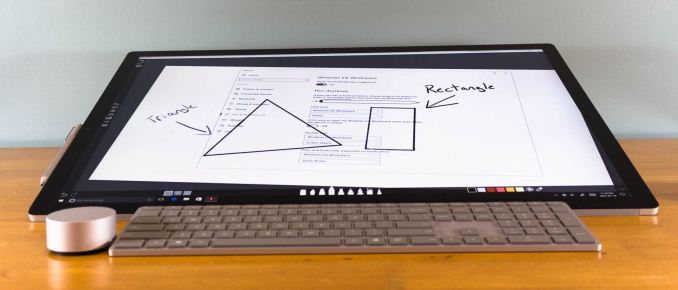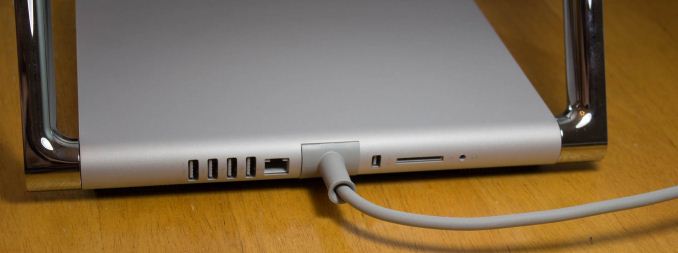The Microsoft Surface Studio Review
by Brett Howse on January 20, 2017 8:00 AM EST- Posted in
- Desktop
- Microsoft
- Surface
- Surface Studio
Design and the Zero-Gravity Hinge
Microsoft has built a brand around Surface, and that’s not an easy thing to accomplish. The Surface Studio fits in very well with the design ethos of the rest of the Surface lineup, and there has been quite a bit of attention to details paid in the creation of their first desktop computer. The first, and most obvious, is the finish, which matches perfectly with the other Surface devices, despite being made from aluminum rather than the magnesium alloy used on the portable products.
The 3:2 aspect ratio of the Surface Studio display is now a hallmark of the Surface brand (outside of Surface Hub), and having a taller display makes doing most tasks on a desktop a more pleasant experience. The increased surface area can’t be forgotten either, with the Surface Studio offering 17% more screen real estate than what's arguably the Studio's closest competitor, the 27-inch iMac, which amounts to an additional 54 square inches of display. Widescreen at 16:9 has never been a great aspect ratio for PC tasks, but the proliferation of high definition television seems to have moved the entire industry this way in an effort to save costs. When looking at the price of the Surface Studio, it’s important to remember that the entire display industry has moved to 16:9 as a standard, which impacts the entire supply chain and tooling required. Moving to an aspect ratio outside of 16:9 has large cost implications, but the end results are certainly worth it. Hopefully we will see a few other manufacturers use this as a means to source displays like this, much like the Surface Pro 3 and Pro 4 have ushered in more 3:2 devices at that much smaller size. And speaking of attention to detail, the Surface Studio is actually 28.125-inches diagonal, and as we'll see in a bit, that last 0.125-inches is very important.
It seems with Surface, Microsoft always wants to have a trick up their sleeve. With the original Surface RT and Surface Pro, it was the kickstand, which has been adopted by quite a few manufacturers for their own device since it works so well. When they launched their first laptop, the Surface Book, it was the muscle wire locking mechanism to remove the display from the base, as well as the dynamic fulcrum hinge to make the top-heavy laptop more stable. With the Surface Studio, the zero-gravity hinge is most definitely its signature design feature.
With two chrome arms flanking the base, the Surface Studio can almost effortlessly be folded down into a drafting table. The hinge mechanism provides a perfect counterbalance to the weight of the display, making it feel like it has almost no weight at all. The hinge is a single movement as well, so you don’t tip and fold the screen, but instead folding the screen also causes it to move down. While this does limit the functionality somewhat – for instance, you can't move the screen half way down and then fold it up straight again – the result is truly a wonderful design which almost needs to be seen in person.
Because you can’t tip the screen without folding it, once you stop at any angle, the screen is very solid to work with, although it is the most secure when folded all the way down to the 20° angle. You would think a large desktop display would not be ideal to use with touch, but the Surface Studio zero-gravity hinge invites you to be more interactive with it, by keeping the display close and folding it down when needed. More traditional all-in-one computers with a touch screen are nowhere near as easy to work with, since holding your arm in dead-air can be tiring, but the folded display doesn’t suffer from these burdens.
The PC base also exudes Surface quality, with the signature color, and cooling vents all the way around in the same fashion as the Surface Pro and Surface Book. The PC base can be disassembled from the bottom if required, for access to the storage and fans, but the remainder of the system is soldered to the board as you would expect in a small form factor device like this. The most frustrating part of the Surface Studio base is that all the inputs and outputs are on the rear of the device, so connecting something over USB, or inserting a SD card into the PC, is not as simple as it should be. This is a form over function decision, and it would be nice to see some of the ports offered at least on the side of the base to make it a bit easier to access.
The desktop PC market has not been as exciting to watch as the smaller and more portable laptops and tablets, but the Surface Studio sets a new high mark for desktop PC design and looks. Some of the decisions are form over function, but the majority of the design decisions actually improve the user experience. The zero-gravity hinge is a masterpiece of engineering, with such a smooth action that it really does feel like the display has no mass at all.













197 Comments
View All Comments
Manch - Sunday, January 22, 2017 - link
The tech came from a company called perceptive pixel which MS bought out. It used to require some hefty GPU & CPU resources to work one of those tables. It still does in a sense, but nowhere near as it used to be. MS helped refine the tech quite a bit.theuglyman0war - Saturday, January 28, 2017 - link
I really hope they do not stop dev of the dial idea. I'd love future iterations with inner and outer rings for more navigation possibilities. Hopefully supporting an open Development community like they did with Kinect.I have dreams Of GVG grass Valley Group shuttle seek sexiness that is portable as a puck and whose position onscreen can be programmed by me for the tools and pipelines I greedily need that is unique to my needs.
I want! almost as much as I want them to go up to a 36 inch display! ( which would had been the smallest canvas I ever stretched to paint on. Crazy! I live in a world where smaller is always better. It is not )
TEAMSWITCHER - Friday, January 20, 2017 - link
The only big advantage I see is the hinge and pen driven touchscreen. This product reminds me of the flying car... Where your target market is limited to people that have a pilot licence and want to drive an ugly unsafe car. Surface Studio appeals most to the artist that does not care about value or performance.Brett Howse - Friday, January 20, 2017 - link
OK so the advantages of this are exactly it's strong points. Good to know.Manch - Sunday, January 22, 2017 - link
^^^LMFAO!!!melgross - Friday, January 20, 2017 - link
Now, if Microsoft can figure out how to sell any of these things. They haven't broken 4 million in yearly sales for the Surface line of tablets yet. In fact, going by the sales numbers in dollars, they sold just about 3.7 million in the past 12 months. I really don't know why such a big deal is being made of these things.Surface Book sales are very poor too. There's a lot of hype going on about these products, which seems to be wasted words.
nathanddrews - Friday, January 20, 2017 - link
It takes a couple years for the enterprise world to catch up. Lots of businesses still running Windows 7, lots of competition from HP and Dell hardware, especially in the tablet/convertible space. Extended Windows 7 support ends in 2020...melgross - Friday, January 20, 2017 - link
The enterprise has had plenty of time. Surface Pro products seem to mostly be used by IT. I've never seen one anywhere else. They are very expensive, particularly for a Windows product, as is this.Icehawk - Sunday, January 22, 2017 - link
We have a few but they are limited to the execs due to cost vs normal laptops, they don't work with multiple monitors reliably which is great fun to supportSaolDan - Sunday, January 22, 2017 - link
you must live in California.